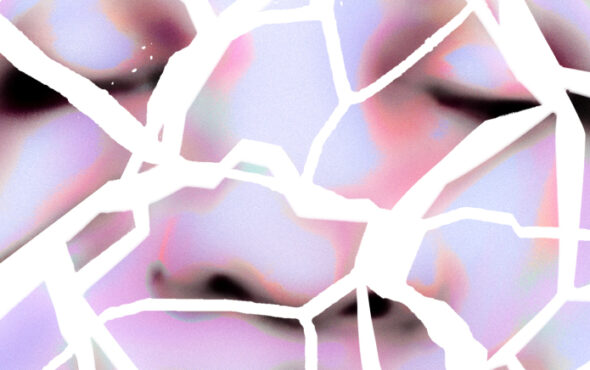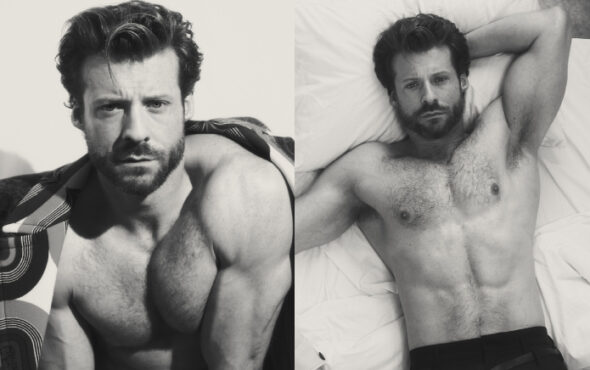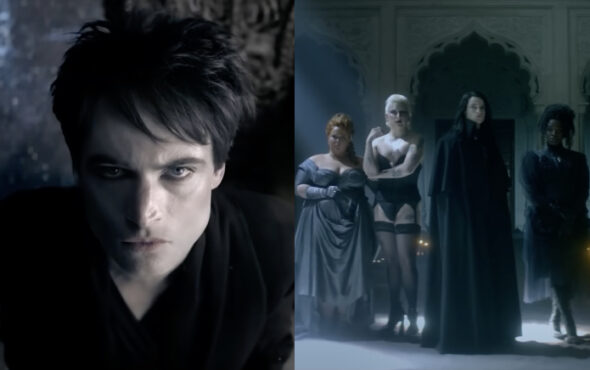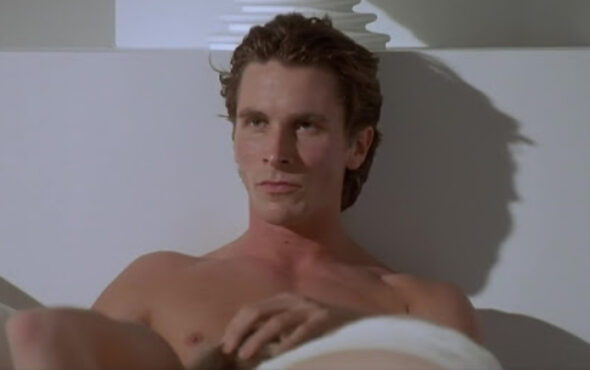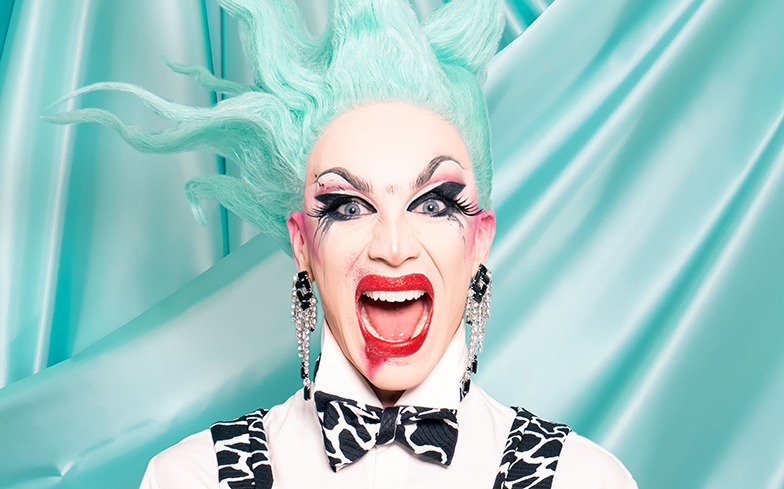
“I think it can be really transcendent to face pain through the art of drag.”
This March, Sasha Velour will be returning to the UK with their one-queen show, Smoke & Mirrors, a 90-minute extravaganza that combines drag, live theatre, visual art, magic, personal storytelling and a reenactment of the iconic So Emotional lip-sync.
The tour, which they created and directed themselves, has garnered widespread critical acclaim and praise from stars such as Troye Sivan, Allie X, Willam, Courtney Act, Alyssa Edwards, Peppermint, Shea Coulee and Alexandria Ocasio-Cortez.
Later this year, Sasha is also bringing their high-concept show Nightgowns to the upcoming short-form digital service Quibi.
The eight-episode docu-series, which is directed by the incomparable Sophie Muller, will follow Sasha and the members of their team as they craft a legendary lip-sync performance, all while we go behind-the-scenes of their creative process.
To commemorate Sasha’s soon-to-be iconic 2020, we caught up with the former GAY TIMES cover star to discuss Smoke & Mirrors, Nightgowns and why the inclusion of more diverse performers is “necessary” for the future of Drag Race.
Where did the idea of Smoke & Mirrors stem from?
The idea of the show came from a number going wrong, technically. Now that first act takes that shape and expands on it, but basically as my projection and digital world fell apart on a tour in Brazil, I discovered that there’s something so human and authentic about watching someone cope with disaster and still make it entertaining. I felt like I had actually outperformed what I had planned by dealing with disaster, so I thought about working disaster into it on purpose, which reminded me of these traditional magic shows and a lot of popular theatre that I’ve rehearsed and choreographed. So I thought, ‘Why not have that be part of a drag show?’ On a lot of levels, too. Some of the numbers have it in a short way, like when I slice myself in half [laughs]. Some have it in a more immersive way, like when the projection malfunctions and my costume falls apart. Then there’s more metaphorical ways, too, in which I kind of reveal that even while doing this illusion of perfect drag, I’ve been struggling behind the scenes for some of the past year with health and mental health issues. It’s that disaster there that has to be faced and overcome, and I think facing that on stage in different ways is a classic, cathartic theatre experience and I love when drag takes a hand out of your catharsis on stage. I think it can be really transcendent to face pain through the art of drag.

Every iconic song you used in the show were completely removed from each other genre-wise – how did you come up with the setlist?
Thank you so much for saying that. Doing iconic songs was one of the concepts for the show. I wanted it to be music that was beloved by queer people and queer audiences, specifically, even to the extent that the live performance of Judy Garland had on the queer people who were screaming in the background. I tried to make sure that there was representation from all the decades, and I thought that kind of balance would keep people’s interest. I wasn’t sure if an hour and a half long lip-syncing show would hold people’s interest, because one of my challenges putting the show together was staying true to the thing I love, which is lip-syncing and narrative storytelling. So jumping from different genres of music seemed like a good strategy and before I even fully realised what I was going to be saying on stage, I had the order of the songs mapped out. It was like coming up with a DJ set almost [laughs].
You’ve spoken about the influence your late mother has had on your art – how did she influence Smoke & Mirrors?
It’s definitely true that my mom has inspired many different aspects of my drag. She is the one who taught me how to make costumes and clothing, to start with. She was a dancer and encouraged me to be graceful and learn how to dance around the house, how to move… I was thinking about her a lot when I was putting the show together. I really reflect on the moment that she died because that was really the moment that I turned to drag with all my attention. When she got sick, I quit my day job so I could spend more time with her, and when I came back I had nothing to do, so I was like, ‘I’m going to see if I can make my living doing drag and doing freelance graphic design,’ which is what I did prior to going on Drag Race. Whenever I think about drag and the origins of my drag story, I do think about my relationship with my mom. One of the goals of Smoke & Mirrors was to tell that story, to tell the story of the world that drag had played in my life, in my own way. That is the story that RuPaul’s Drag Race told on TV, in their way, and people loved it. I loved it. But I wanted to tell it in my own language through speeches, essays, lip-sync performance. The way that I talked about my relationship with my mom and my mom’s death is very different than how it comes across on TV, and that was very important to me. I think she would love the way that I talk about her in the show. It captures the complexity of our relationship and the fullness of her as a real person, she was complex and she came with her own set of opinions and beliefs.
The visual of the tree at the end of the show was one of the most powerful moments of Smoke & Mirrors… is that a homage to your mother?
A lot of the visuals from the show connect to images from the course of my life. The tree that the show ends with is inspired by a real tree that was on a hill outside my house in the town where I lived. I would often walk near it with my mom, and I would spend a lot of time crying into the tree in the days after she passed away. I’ve done work surrounding the tree before, but in a way, the role of the tree in Smoke & Mirrors has many different layers, but it’s connected even on that level too. It paints a whole picture of images, some of my life and my story.

Do you often get messages from fans who have also experienced loss?
People who have lost a family member that close have this set of shared things that we can connect about. I always feel a little relief being able to share that with other people. When I was doing bar shows, sometimes I would talk a little bit about my mom, the stuff that I was going through at that time. People would be able to connect with it, even if they hadn’t had that exact experience. I would do hour-long group therapy sessions after the show was after, like on the edge of the stage talking to people [laughs]. I think that still happens with Smoke & Mirrors, but on an even larger scale. Because Smoke & Mirrors is so visual, I wanted to make it eye-grabbing so that even if you don’t know sadness or darkness or eternal anxiety, there’s still something to latch onto. But the people who are able to gather and take it apart on every level, it makes me so excited, that people are looking at it and connecting with it, so I do get messages from people. I think there’s a group chat actually, where people are like, ‘Okay, this song… what does the performance represent?’ I love when people interpret something totally different, based on their own experiences.
Congratulations on your upcoming Nightgowns series – what can fans expect?
Nightgowns is a show that I’ve been producing since 2013. It’s kind of had a consistency right from the beginning. I’ve wanted to purposefully capture some of the diversity of what drag is, in the line-up of a single performance. That means drag kings, always trans and AFAB performers, who are not always welcome in drag spaces on drag competitions, and then a real variety of song choices and performance style and different backgrounds from the performers as well; socio-economic backgrounds, approach to fashion, approach to humour, the more different drag gets the more exciting the night of entertainment becomes. All of that is there with this Nightgowns TV series, you get to see a full show. We’ve shortened it to only be eight performances, but you get to see the full performance captured in a live theatre for film. We have an amazing video director, Sophie Muller, filming our humble little drag show and transforming it into something that people can really enjoy. It’s hard to film a lip-sync number and have it translate, it has a lot to do with camera angles and editing and all that stuff. On top of the night of entertainment that you would see if you came to see a drag show, we’re pulling back the curtain a little bit – to overuse my favourite metaphor! What exists behind the scenes of a drag show? What kind of energy do people have in the dressing room? How are we talking together, helping each other? And how do these numbers come to life? The best part is, because of the platform this show is airing on called Quibi, all the episodes are under 10 minutes. It’s really effective because there’s no filler. There’s no wasted time, there’s no padding, it’s all just really to the point and exciting. We already understand the value of a comedy, we do three minute lip-syncs that try to explain everything we are feeling. I think it’s a natural fit.
How important is it for established drag artists, like yourself, to champion performers who haven’t had a chance to appear on an Emmy Award-winning reality drag competition?
There’s different ways to do it, but I think it’s really important to remember that we’re not inventing anything groundbreaking with drag. We are upholding an important tradition that has a really strong history with really deep roots in the community. It’s not necessarily important to shine a light on other people but I think having some awareness of the history and context of this art-form is important, and I think that’s a little bit missing from how drag is talked about in contemporary media platforms. I’m always trying to shift it to other people, let’s look at the whole community. The phenomenon is really the community, it’s not these exceptional individuals. The phenomenon is also this amazing history of drag, people don’t realise how theatrical and artistic drag has been from the beginning of time… how political, as well.
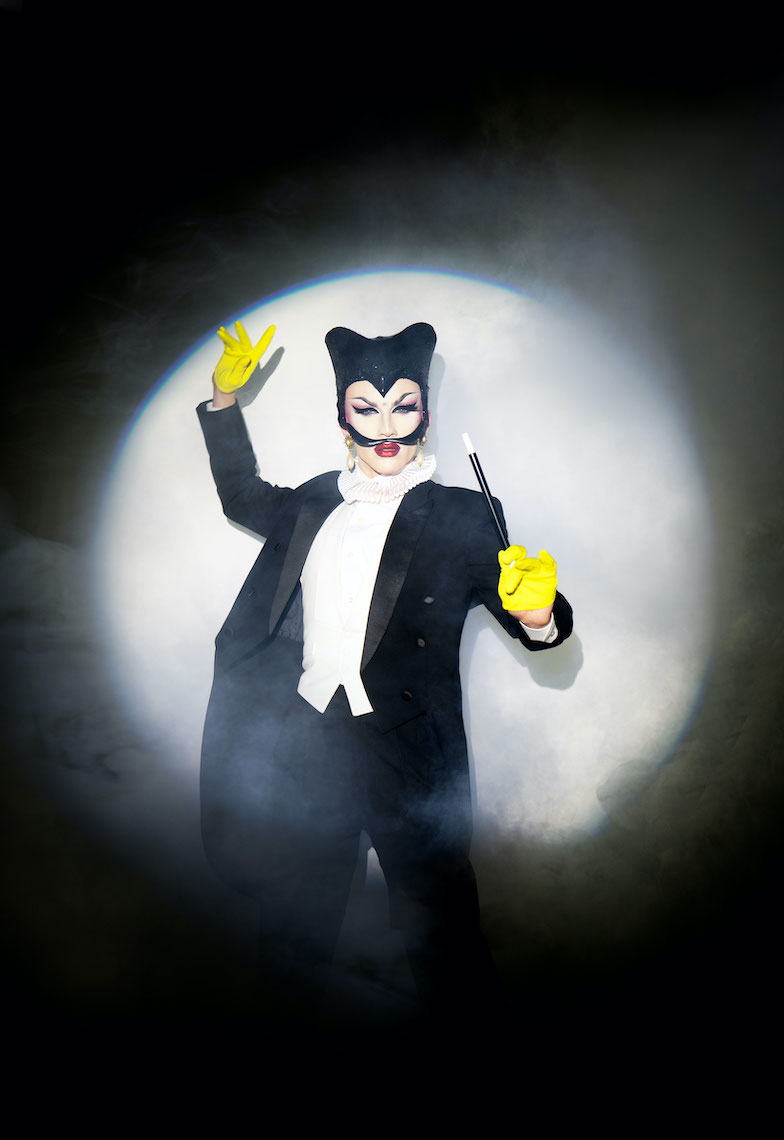
We’re still dealing with people who say that only cisgender men can practice the art-form when women were performing as drag kings in the early 1900s, such as Vesta Tilley and Ella Shields – what would you say to those people?
What’s to say to them? Because that’s just not the truth. How do you even unpack where that idea comes from? People will act like they know things they don’t. The history speaks for itself. I’ve always had ambition to work on a real documented history of drag. There are some out there, but they are hard to access. But… the history has our backs. We’ve got to get that out there better.
We’ve just had a drag king win Dragula and a trans queen win Drag Race Thailand, so you’d think people wouldn’t be this ignorant…
[Laughs] And if you go to any drag show today! I think the most exciting performances are coming from trans, non-binary, AFAB and drag king performers. Long before I was ever a part of RuPaul’s Drag Race, I was a huge fan of drag. I’m like a wannabe scholar of drag, I went to an academic conference about American pop culture and went to a lecture about the art of drag. When I arrived, it was just about the different types of drag that appeared on RuPaul’s Drag Race. I remember being horrified. It’s like, ‘Maybe you should go and actually watch what’s happening in the local community,’ because that’s what drag is. Drag is what exists in the world, not the product of a single television show. I don’t think RuPaul’s Drag Race is the representative of all things drag [laughs]. Maybe they would enjoy taking that title but I think it’s important that a television show doesn’t stand for an entire art-form.
Do you see the show becoming more diverse in the future?
I don’t know how to predict what they will do, but I think they should. It would be positive and exciting for the competition, good for the television drama. I think there’s no reason not to expand the cast a little bit more. There are no limitations on who can audition for Drag Race, but the casting… I’m excited to see some shifts there. To my mind, it’s almost necessary for the future of the show, but I don’t know what decisions they’ll make. But it’s like you said, a trans woman just won Drag Race Thailand. It is expanding, so eventually it’ll reach the centre.

My final question for you, and this is for the fans: will we ever see a comeback for you on Drag Race?
I don’t know! I don’t know if they want me back, to be honest. They’re not beating down the door to ask me to return, I’ll tell you that. You know, I always love being on television. I’m not against it. I’m not a huge believer in the value of competition, right now. How could anyone who’s already won one disagree with that? [Laughs] There’s no reason to return to competitions when you’ve already won your crown. But I also, philosophically, think it’s better to talk about everyone’s strengths than to pick a single winner. I say that as someone who has gone through it, but also someone who has experienced what it’s like to compete against artists that I really care about and respect. It’s not my favourite situation, necessarily.
Sasha Velour will return to the UK with Smoke & Mirrors from 2 March until 25 March – you can purchase tickets here.
